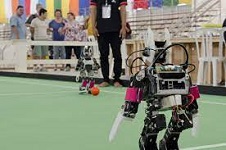In February, the Department of Basic Education confirmed that it would officially get going with the introduction of Coding and Robotics in South African schools.
As it awaits feedback from the regulator on the proposed curriculum, Dr Benadette Aineamani, Director of Product & Services at global education group, Pearson Africa believes that aspects such as 1) the link between Mathematics and Coding and Robotics, and 2) the role of language in teaching and learning, need to be considered before South Africa’s schools are ready for such a technically advanced subject.
Having dedicated her life to understanding how teaching can be most effective, Aineamani says, “there is a need to unpack the pedagogical content knowledge that is required to teach Coding and Robotics at different phases in the schooling system.
Similar to doing Mathematics, Coding and Robotics requires learners to make sense of the challenge that is presented to them and persist to solve the problem. Concepts that are taught in Mathematics an such as algorithmic and computational thinking are also required when doing Coding and Robotics.
Therefore, effective pedagogies need to be used when teaching Coding and Robotics to ensure that learners are provided with the opportunities to develop the required concepts and skills that will enable them to progress in the subject.
Part of the challenges in teaching and learning subjects such as Mathematics and Science in South Africa comes down to the language aspect. Language complexities in South African multilingual classrooms have been well researched and various recommendations have been suggested by experts in the field. Famed educationalist, Dr James Cummins is a Professor with the department of Curriculum, Teaching, and Learning at the University of Toronto once said, “To reject a child’s language in school is to reject the child”.
In South Africa, Aineamani says that many children in Grade R-3 come to school with a language that they have already developed at home. “This is the language that they have been using to communicate, this may be not be the same as the language of teaching and learning. The school system should embrace the learner’s language that is already developed and use it as a resource to help the learner understand concepts and skills that are taught in the language of teaching and learning.”
Due to the technical nature of Coding and Robotics, Aineamani says Coding and Robotics should also be taught in a way that allows learners’ mother tongues to be used as a resource to develop the skills and concepts in the subject.
“For this to be successful, a conscious effort should be made to develop an effective register for Coding and Robotics in all the official languages. This will then enable teachers and learners to have a vocabulary available to them when using any language as a resource to teach or learn concepts and skills in Coding and Robotics.”
In her role at Pearson, Aineamani believes that the starting point is to create awareness of the complexities of language, and the importance of using language as a resource in teaching and learning. “Through various engagements with teachers, we highlight the complexities of language in multilingual classrooms, and provide some tips on how teachers can use language effectively as a resource rather than a limitation in teaching and learning.”
In developing its materials, Aineamani says Pearson has put measures in place to ensure that the teaching and learning materials are accessible to multilingual learners and teachers through careful use of terms, and drawing on appropriate contexts to illustrate concepts, and developing translations where possible.
In cases where translations are not possible, original content is developed within the context of various languages instead of direct copies that become lost in translation.
“As South Africa introduces Coding and Robotics in Schools, there is a need to acknowledge the challenges that have been extensively researched in the teaching and learning of Mathematics and Science. Due to the link between Mathematics, Science and Coding and Robotics, these challenges can be used to inform decisions that need to be taken in order to successfully implement the subject. ,” concludes Aineamani.

